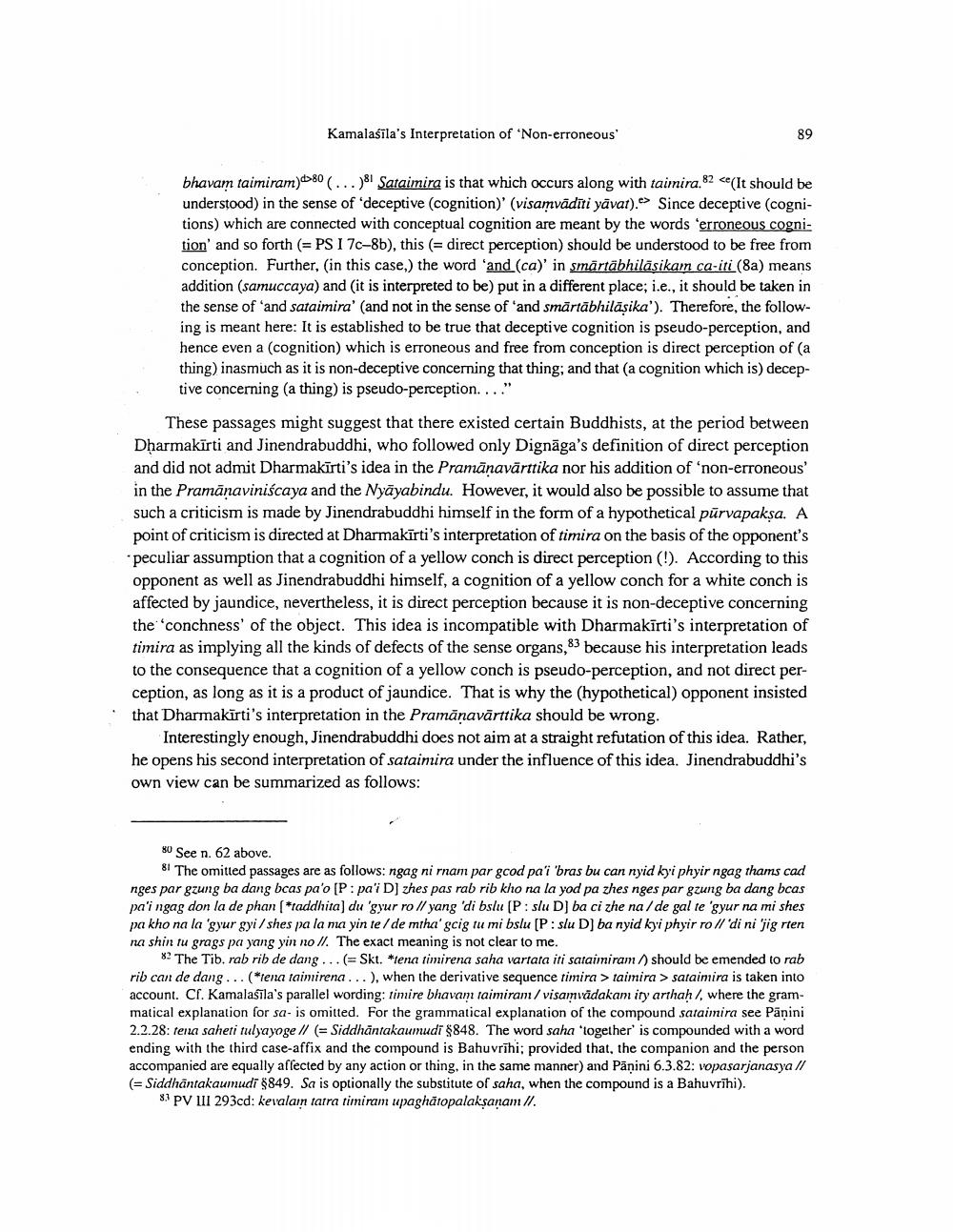________________
Kamalasila's Interpretation of 'Non-erroneous'
89
bhavam taimiram) 80 (...)81 Sataimira is that which occurs along with taimira.82 <e(It should be understood) in the sense of 'deceptive (cognition)' (visamvādīti yāvat). Since deceptive (cognitions) which are connected with conceptual cognition are meant by the words 'erroneous cognition' and so forth (= PS I 7c-8b), this (= direct perception) should be understood to be free from conception. Further, (in this case,) the word 'and (ca)' in smārtābhilāṣikam ca-iti (8a) means addition (samuccaya) and (it is interpreted to be) put in a different place; i.e., it should be taken in the sense of 'and sataimira' (and not in the sense of 'and smartābhilāṣika'). Therefore, the following is meant here: It is established to be true that deceptive cognition is pseudo-perception, and hence even a (cognition) which is erroneous and free from conception is direct perception of (a thing) inasmuch as it is non-deceptive concerning that thing; and that (a cognition which is) deceptive concerning (a thing) is pseudo-perception...."
These passages might suggest that there existed certain Buddhists, at the period between Dharmakirti and Jinendrabuddhi, who followed only Dignaga's definition of direct perception and did not admit Dharmakirti's idea in the Pramāṇavārttika nor his addition of 'non-erroneous' in the Pramanaviniścaya and the Nyāyabindu. However, it would also be possible to assume that such a criticism is made by Jinendrabuddhi himself in the form of a hypothetical purvapakṣa. A point of criticism is directed at Dharmakirti's interpretation of timira on the basis of the opponent's *peculiar assumption that a cognition of a yellow conch is direct perception (!). According to this opponent as well as Jinendrabuddhi himself, a cognition of a yellow conch for a white conch is affected by jaundice, nevertheless, it is direct perception because it is non-deceptive concerning the 'conchness' of the object. This idea is incompatible with Dharmakirti's interpretation of timira as implying all the kinds of defects of the sense organs,83 because his interpretation leads to the consequence that a cognition of a yellow conch is pseudo-perception, and not direct perception, as long as it is a product of jaundice. That is why the (hypothetical) opponent insisted that Dharmakirti's interpretation in the Pramāṇavārttika should be wrong.
Interestingly enough, Jinendrabuddhi does not aim at a straight refutation of this idea. Rather, he opens his second interpretation of sataimira under the influence of this idea. Jinendrabuddhi's own view can be summarized as follows:
80 See n. 62 above.
81 The omitted passages are as follows: ngag ni rnam par gcod pa'i 'bras bu can nyid kyi phyir ngag thams cad nges par gzung ba dang bcas pa'o [P: pa'i D] zhes pas rab rib kho na la yod pa zhes nges par gzung ba dang bcas pa'i ngag don la de phan [*taddhita] du 'gyur ro // yang 'di bslu [P: slu D] ba ci zhe na/ de gal te 'gyur na mi shes pa kho na la 'gyur gyi/ shes pa la ma yin te/de mtha' gcig tu mi bslu [P: slu D] ba nyid kyi phyir ro // 'di ni 'jig rten na shin tu grags pa yang yin no //. The exact meaning is not clear to me.
82 The Tib. rab rib de dang... (= Skt. *tena timirena saha vartata iti sataimiram / should be emended to rab rib can de dang... (*tena taimirena...), when the derivative sequence timira > taimira > sataimira is taken into account. Cf. Kamalasīla's parallel wording: timire bhavam taimiram/visamvadakam ity arthaḥ /, where the grammatical explanation for sa- is omitted. For the grammatical explanation of the compound sataimira see Pāņini 2.2.28: tena saheti tulyayoge // (= Siddhantakaumudi §848. The word saha 'together' is compounded with a word ending with the third case-affix and the compound is Bahuvrihi; provided that, the companion and the person accompanied are equally affected by any action or thing, in the same manner) and Panini 6.3.82: vopasarjanasya // (= Siddhantakaumudi $849. Sa is optionally the substitute of saha, when the compound is a Bahuvrīhi).
8.3 PV III 293cd: kevalam tatra timiram upaghatopalakṣaṇam //.




